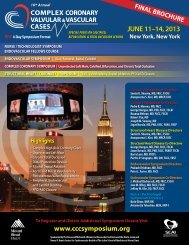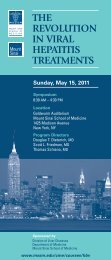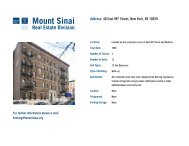December 2, 2012 [PDF] - Mount Sinai Hospital
December 2, 2012 [PDF] - Mount Sinai Hospital
December 2, 2012 [PDF] - Mount Sinai Hospital
Create successful ePaper yourself
Turn your PDF publications into a flip-book with our unique Google optimized e-Paper software.
November 12 - <strong>December</strong> 2, <strong>2012</strong>inside<strong>Mount</strong> <strong>Sinai</strong>Care and ShelterFrom the StormOn behalf of the <strong>Mount</strong> <strong>Sinai</strong> Boards of Trustees, I wantto express profound appreciation for the extraordinaryefforts of physicians, nurses, staff, students, and executiveleaders as Hurricane Sandy assaulted New York City andmuch of the East Coast of the United States.William Donovan, born three weeks early with congenital heartdisease, looks at his mother Jennie from the safety of his bed in<strong>Mount</strong> <strong>Sinai</strong>’s Neonatal Intensive Care Unit. He arrived from NYULangone Medical Center at the height of the storm.Putting patient, neighborhood, andstaff safety first, leaders at The <strong>Mount</strong><strong>Sinai</strong> Medical Center activated theEmergency Command Center at 6 pm onSunday, October 28, and the responsewas swift, coordinated, and trulyexemplary. Physicians, nurses, and staffreported to duty and on that first night,more than 300 volunteers—includingmany students—stayed on campus,sleeping in shifts to ensure full staffingin all areas.(continued on back page)Peter W. May,Chairman, Boardsof Trustees,The <strong>Mount</strong> <strong>Sinai</strong>Medical CenterSwift Response and Selfless Dedication:A Letter From Kenneth L. Davis, MDIt has been two weeks since Hurricane Sandy made landfallin the greater New York City area, and since that time, The<strong>Mount</strong> <strong>Sinai</strong> Medical Center has operated beyond its regularinpatient capacity and will continue to do so for the nextfew weeks. Our ability to coordinate a strong-and-nimbleresponse during a citywide crisis, and to provide continuous,high-level care to so many patients, is a testament to theoutstanding staff we have in all areas of the institution.LookinsideA <strong>Hospital</strong>, PreparedStudents ProvideVital Support<strong>Mount</strong> <strong>Sinai</strong>Hosts Three-DaySinaInnovationsConferenceTo put patients first under extraordinarily challengingcircumstances, you made great personal sacrifices. Youorganized car pools when public transportation was down,arranged child and elder care on short notice, slept inad-hoc dormitories and on your office floor; you also delayedresolving your own storm-related problems in order to keep<strong>Mount</strong> <strong>Sinai</strong> <strong>Hospital</strong> fully staffed. These and other selflessacts brought peace of mind to all of our patients and theirfamilies during a harrowing time. I could not be more proudof your effort, performance, and commitment.(continued on back page)In the aftermath of Hurricane Sandy,Kenneth L. Davis, MD, President andChief Executive Officer of The <strong>Mount</strong><strong>Sinai</strong> Medical Center, LEFT, toured <strong>Mount</strong><strong>Sinai</strong>’s Neonatal Intensive Care Unit withCNN Chief Medical Correspondent SanjayGupta, MD, to visit some of the tiniestpatients who were brought there.
A <strong>Hospital</strong>, PreparedThe <strong>Mount</strong> <strong>Sinai</strong> Medical Center was preparing for an increase inthe demand for emergency and inpatient services as HurricaneSandy approached. “Patients who were scheduled to be releasedfrom <strong>Mount</strong> <strong>Sinai</strong> were safely discharged before the inclementweather, and all ambulatory and elective services were postponedto accommodate new patients,” said Wayne Keathley, President andChief Operating Officer, The <strong>Mount</strong> <strong>Sinai</strong> <strong>Hospital</strong>.When NYU Langone Medical Center and Bellevue <strong>Hospital</strong> Centerlost power, <strong>Mount</strong> <strong>Sinai</strong> was ready with beds and staff to accept107 evacuated patients, many of whom had serious and complexconditions and arrived with sparse medical records. "Physicians,nurses, support, and ancillary staff all worked side by side to handlethis tremendous influx of patients," said Erin DuPree, MD, ChiefMedical Officer of The <strong>Mount</strong> <strong>Sinai</strong> Medical Center. Kevin Chason,DO, Director of Emergency Management, and Brad Beckstrom,Director of Community and Government Affairs, served as liaisonsto city and state officials, and the Greater New York <strong>Hospital</strong>Association, to coordinate patient transfers.The Medical Center’s Emergency Command Center was activatedand began to make plans for infrastruture protection, patient care,supply procurement, and around-the-clock staffing to keep allpatients and employees safe. "Many RNs, as well as other staff,came to work a day ahead of the storm, and planned to stay for theduration," said Carol Porter, DNP, RN, FAAN, Chief Nursing Officer,Senior Vice President of The <strong>Mount</strong> <strong>Sinai</strong> Medical Center, and theEdgar M. Cullman, Sr. Chair of the Department of Nursing.Building Services set up accommodations for 1,200 staff andphysicians who needed periods of rest, and security personnelcreated shuttle services for employees and patient discharges.Meanwhile, a team of 140 food service department employees keptpatients and staff fed; IT developed extra precautions to safeguardpatient records; Building Services and Engineering personnelhelped transform a former ambulatory cancer treatment center intoan inpatient unit; and Pharmacy and Materials Management staffensured adequate supplies.There are hundreds, if not several thousand <strong>Mount</strong> <strong>Sinai</strong> employeeswho performed selfless acts of personal kindness for colleagues.Among them was Kathleen Leonard, MD, Assistant Professor ofPathology, who emailed Ila Singh, MD, PhD, Vice Chair of ClinicalPathology, the day after the storm: "I have a 4-wheel drive SUV, anda full tank of gas. If there is staff willing to come, I can pick them up.”In the days after the storm, <strong>Mount</strong> <strong>Sinai</strong> continued to reach out tothe New York community. David T. Stern, MD, Professor of Medicine,and Medical Education, took a suggestion from his wife, AlexandraFROM LEFT: In the former Derald H.Ruttenberg Treatment Center, whichwas transformed into an inpatient unit,are Marie Payen, RN; Emma Migrino, RN,BSN; Jeffrey M. Baumgardner, MD, ChiefResident, Internal Medicine; Katie Ip, RN,BSN, MSN, Clinical Nurse Manager; JuliaEagan, LCSW; and Elizabeth Koskinen,LCSW.Members of the Emergency Command Center team, SEATED FROM LEFT:Marianne Coughlin, Vice President, <strong>Hospital</strong> Operations; Carol Porter, DNP,RN, FAAN; Maria Vezina, EdD, RN, Senior Director, Nursing Education andProfessional Practice; Mark Callahan, MD, Chief Medical Officer of theFaculty Practice Associates and <strong>Mount</strong> <strong>Sinai</strong> Network; and Barbara Murphy,MD, Acting Chair, Department of Medicine; STANDING FROM LEFT: ToniMaily, Senior Director, Department of Laboratories; Claudia Colgan, RN,Vice President of Quality Initiatives; David T. Stern, MD; Andrew Dunn,MD, Acting Chief, Division of <strong>Hospital</strong> Medicine; Grace Marin, MBA, MSN,RN, Clinical Program Manager, Cullman Institute; Brian Radbill, MD, ViceChair of Quality for the Department of Medicine; Anne Dickerson, ProjectCoordinator, <strong>Hospital</strong> Administration; and Kenny Chu, Senior Director,IT SecurityAnnabelle Nieves, Security Manager, and volunteers from <strong>Mount</strong> <strong>Sinai</strong>staff, helped load a van with hospital supplies for Staten Island physicians.Ackerman, MD, to Mr. Keathley and Tim Burgunder, Director ofSecurity, to have the hospital help Staten Island. Dr. Stern, his twosons, Harrison and Parker, and volunteers from <strong>Mount</strong> <strong>Sinai</strong> staffbrought 10 boxes of cleaning supplies, sponges, gloves, and garbagebags to Staten Island physicians, donations made possible by BuildingServices and Crothall Healthcare. "<strong>Mount</strong> <strong>Sinai</strong> once again has metthe challenge of providing care under extraordinary circumstances toour patients and our communities,” said Mr. Keathley.Nurses from NYU Langone MedicalCenter were welcomed to <strong>Mount</strong><strong>Sinai</strong> by, FRONT ROW: Erin DuPree,MD, left; Carol Torchen, MSN, RN,Director of Nursing, Women's andChildren's Services, second fromleft; Carol Porter, DNP, RN, FAAN,fourth from left; Peter W. May,Chairman, Boards of Trustees, The<strong>Mount</strong> <strong>Sinai</strong> Medical Center, middle;Kenneth L. Davis, MD, President andChief Executive Officer, The <strong>Mount</strong><strong>Sinai</strong> Medical Center, fifth fromright; BACK ROW: Michael Brodman,MD, Chair, Department of Obstetrics,Gynecology and ReproductiveScience; Rachel Barr, MD, Resident;and Susan Hiraldo, RN.
Students Provide Vital SupportBefore Hurricane Sandy bore down on New York City on Monday,October 29, with 80-mile-an-hour winds and the highest storm tidesever recorded in the region, <strong>Mount</strong> <strong>Sinai</strong> School of Medicine studentswere organized and ready to pitch in. Using the lessons learned fromtheir involvement in Hurricane Irene only a year earlier, members ofthe students’ Disaster Preparedness Committee created their owncommand center in the Patricia and Robert Levinson StudentCenter on the first floor in the Annenberg building, and beganassigning volunteers.“It was incredible how many students stepped up for multiple sixhourshifts,” says Carine Davila, a first-year student and member ofthe <strong>Mount</strong> <strong>Sinai</strong> Student Council, who was one of the organizers. Alltold, some 250 students from the medical school and the GraduateSchool of Biomedical Sciences—almost one-quarter of the studentbody—volunteered their time over several days.Students from the graduate school assisted in making suremore than 200 of <strong>Mount</strong> <strong>Sinai</strong>’s research labs were secure. Theydocumented emergency contacts, checked to make sure digitalthermometers were set to appropriate temperatures on all of therefrigerators and freezers holding experiments, and were readyto transport dry ice in case the power went off. In addition, theychecked for flooding in the classrooms and outpatient clinics.Student leaders coordinated assistance throughout the storm.FRONT ROW, FROM LEFT: Carine Davila, first-year medical student;Lauren Feld, second-year medical student and Chair of the student-runDisaster Preparedness Committee; Rishi Kothari, fourth-year medicalstudent and President of the Student Council. BACK ROW, FROM LEFT:Robert Conley, second-year medical student; Tobias Cohen, third-year MD,PhD student, and former Chair of the Disaster Preparedness Committee;and Alex Peters, second-year medical student“<strong>Mount</strong> <strong>Sinai</strong>’s student volunteerswere organized and tireless in theirefforts to ensure that our clinicaloperations ran smoothly throughoutthe storm and beyond.”— DENNIS S. CHARNEY, MDFROM LEFT: Teddy John Wohlbold and Jacqui Rabkin, both second-yearMD, PhD students; and Jason Rapaport, a second-year medical student,were among 30 volunteers from <strong>Mount</strong> <strong>Sinai</strong> who provided assistanceto elderly residents living downtown without electricity on Saturday,November 3. The students checked on patients’ vital signs, made sureprescriptions were filled, and distributed ready-made meals from theFederal Emergency Management Agency. Photo courtesy of Syd LondonMedical students concentrated their efforts in clinical areas,providing one-to-one patient observations, manning reception desks,and assisting in the arrival of patients from NYU Langone MedicalCenter and Bellevue <strong>Hospital</strong> Center.“<strong>Mount</strong> <strong>Sinai</strong>’s student volunteers were organized and tireless intheir efforts to ensure that our clinical operations ran smoothlythroughout the storm and beyond,” says Dennis S. Charney, MD, theAnne and Joel Ehrenkranz Dean of <strong>Mount</strong> <strong>Sinai</strong> School of Medicine,and Executive Vice President for Academic Affairs of The <strong>Mount</strong><strong>Sinai</strong> Medical Center. “Witnessing their selflessness and dedication,I am confident that they will become scientists and physicians whoare committed, selfless, ethical, and at the same time transformativein their accomplishments."Five faculty members took turns coordinating the students’ effortswith <strong>Mount</strong> <strong>Sinai</strong>’s official command center: Peter M. Gliatto, MD,Associate Dean for Undergraduate Medical Education and StudentAffairs; Basil G. Hanss, PhD, Associate Dean in the School ofBiomedical Sciences, and Associate Professor of Medical Education;David Muller, MD, Dean for Medical Education, and Professor andChair of Medical Education; Valerie Parkas, MD, Associate Dean forAdmissions, and Associate Professor of Medical Education; andPhyllis Schnepf, Associate Dean for Education and TranslationalResearch Operations.“Our students were truly outstanding,” says Ms. Schnepf, the firstfaculty member to work with the students during the storm. “Theyare smart and enthusiastic, and were ready to serve the <strong>Mount</strong> <strong>Sinai</strong>community no matter what the circumstances.”As new patients were admitted to <strong>Mount</strong> <strong>Sinai</strong>, the students steppedin. At 2 am on Thursday, November 1, <strong>Mount</strong> <strong>Sinai</strong>’s command centercalled second-year medical students Paul Peng and Ching See Lau tointerpret for a group of psychiatric patients who had been evacuatedfrom Bellevue <strong>Hospital</strong> and spoke only Mandarin or Cantonese.Mr. Peng, who speaks Mandarin, immediately helped two patients, anelderly man and a young woman. “They told me how extremely tiredthey were,” he says. “I learned how at Bellevue the power outage hadknocked out the hot water, and they had climbed down 18 flights ofstairs before arriving here. Neither patient had ever heard of <strong>Mount</strong><strong>Sinai</strong>. The most memorable part of the night was making the patientsfeel more comfortable in an unfamiliar place.”Says Rishi Kothari, a fourth-year medical student and President ofthe Student Council, “During the storm, we were told time and againhow much of an impact we were making. It made us realize howimportant we are to an institution as large as <strong>Mount</strong> <strong>Sinai</strong>.”
Care and Shelter From the Storm (continued from page 1)On Monday night, October 29, as HurricaneSandy made landfall and battered the Citywith sustained and violent winds and rain,<strong>Mount</strong> <strong>Sinai</strong>’s leaders coordinated with thoseat NYU Langone Medical Center to receivetransfer patients when NYU experienced apower outage. That night, thanks to strongand steady efforts of hundreds of volunteers,<strong>Mount</strong> <strong>Sinai</strong> took in 64 patients from NYUand one from Bellevue <strong>Hospital</strong> Center.Patients arrived—and were immediatelyand expertly cared for—in the areas ofadult critical care, including transplant;pediatric critical care; neonatal intensivecare; and obstetrics.That night, more than 600 volunteersrepresenting all areas of the MedicalCenter slept in shifts on campus, and onTuesday, <strong>Mount</strong> <strong>Sinai</strong> prepared to take inadditional patients.Throughout the crisis, <strong>Mount</strong> <strong>Sinai</strong>’s press,digital, and social media teams maintaineda seamless stream of updates for patients,concerned families and friends, the media,and the general public on the institution’swebsite, as well as on Facebook andTwitter. This is digital technology at itsvery best—when it is used to disseminatecritical information and highly anticipated,newsworthy updates to worriedconstituent groups.In the darkest hours of the storm, the spiritof family and community shone brightand bold at <strong>Mount</strong> <strong>Sinai</strong>, and knowing ourstaff, it will endure throughout the recoveryeffort. My pride, and that of every memberof the Boards of Trustees, for <strong>Mount</strong> <strong>Sinai</strong>’sphysicians, nurses, staff, students, andleaders cannot be overstated. It is duringcrises such as these, that we all witness andappreciate the outstanding institution thatwe all represent—and the truly extraordinaryindividuals who make it so.— Peter W. May, Chairman,Boards of Trustees,The <strong>Mount</strong> <strong>Sinai</strong> Medical CenterSwift Response and Selfless Dedication (continued from page 1)This successful effort began with high-levelstrategy meetings in the days prior to thestorm’s arrival, and commenced in full withthe activation of the Emergency CommandCenter at 6 pm on Sunday, October 28. This70-person unit—which meets and trainsregularly throughout the year—had a rangeof experts on duty during the storm and formore than a week as the recovery began.This was the fifth time in 10 years that thecenter was fully activated. In addition, morethan 1,000 physicians and nurses, as wellas a broad range of support staff—fromsecurity, IT, food service, and facilities—stayed overnight on campus to ensureadequate staffing for inpatient care and theEmergency Department.Because many of <strong>Mount</strong> <strong>Sinai</strong>’s subfloorsare below the water table, and in closeproximity to the Jacqueline Kennedy OnassisReservoir in Central Park, engineering staffand volunteer medical students securedthose areas with cinder blocks and specialinsulation. Engineers also made every effortto ensure that electrical power would not failus. The institution’s electrical infrastructureconsists of several separate power systemsthat support the campus and 13 back-upgenerators. This means that if <strong>Mount</strong> <strong>Sinai</strong>had lost power, the back-up system wouldhave immediately mobilized. The generatorsand transfer equipment are testedmonthly in accordance with local andnational standards.Owing to this preparation—and to aroundthe-clockstaffing—<strong>Mount</strong> <strong>Sinai</strong> was able tocoordinate the transfer of more than 100patients, many in critical-care units, fromNYU Langone Medical Center and Bellevue<strong>Hospital</strong> Center when those institutionslost power.Hurricane Sandy was a natural disaster ofunprecedented size and scope for New YorkCity, and throughout the crisis, <strong>Mount</strong> <strong>Sinai</strong>has been at its very best.— Kenneth L. Davis, MD,President and CEO,The <strong>Mount</strong> <strong>Sinai</strong> Medical CenterNovember 12 - 14, Stern AuditoriumBreakfast and Registration at 7:30 amFeatured Speakers:Ivan SeidenbergRetired Chairman and CEO, VerizonDavid ZaslavPresident and CEO,Discovery CommunicationsElazer R. EdelmanThomas D. and Virginia W. CabotProfessor, Health Sciences andTechnology (MIT)Jeffrey HammerbacherFounder and the Chief Scientist,Cloudera, and Faculty, <strong>Mount</strong> <strong>Sinai</strong>School of MedicineKenneth L. Davis, MDPresident and CEO,The <strong>Mount</strong> <strong>Sinai</strong> Medical CenterDennis S. Charney, MDAnne and Joel Ehrenkranz Dean,<strong>Mount</strong> <strong>Sinai</strong> School of MedicineScott L. Friedman, MDFounding Dean for Therapeutic Discoveryand Chief of the Division of Liver Diseasesat <strong>Mount</strong> <strong>Sinai</strong> School of MedicineInside <strong>Mount</strong> <strong>Sinai</strong><strong>2012</strong> Marketing & CommunicationsCarrie Gottlieb, EditorMarilyn Balamaci, EditorSubmissionsBox 1475inside@mssm.eduVisit Inside on the Webwww.mountsinai.org/insideTo find out what’s happeningright now, follow <strong>Mount</strong> <strong>Sinai</strong>on Twitter @<strong>Mount</strong><strong>Sinai</strong>NYCVisit us on Facebookfacebook.com/mountsinainyc


![December 2, 2012 [PDF] - Mount Sinai Hospital](https://img.yumpu.com/51092274/1/500x640/december-2-2012-pdf-mount-sinai-hospital.jpg)
![January 21, 2013 [PDF] - Mount Sinai Hospital](https://img.yumpu.com/50916550/1/190x245/january-21-2013-pdf-mount-sinai-hospital.jpg?quality=85)
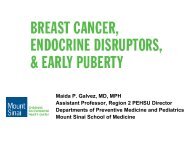
![February 3, 2013 [PDF] - Mount Sinai Hospital](https://img.yumpu.com/50584982/1/190x245/february-3-2013-pdf-mount-sinai-hospital.jpg?quality=85)
![March 18, 2012 [PDF] - Mount Sinai Hospital](https://img.yumpu.com/50462098/1/190x245/march-18-2012-pdf-mount-sinai-hospital.jpg?quality=85)
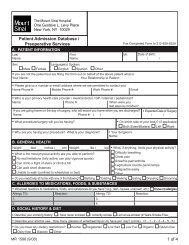
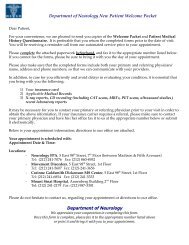
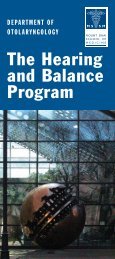
![Partners Program Guide [PDF] - Mount Sinai Hospital](https://img.yumpu.com/49411954/1/190x245/partners-program-guide-pdf-mount-sinai-hospital.jpg?quality=85)
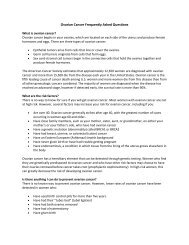
![March 19 - April 1, 2012 [PDF] - Mount Sinai Hospital](https://img.yumpu.com/48990923/1/190x245/march-19-april-1-2012-pdf-mount-sinai-hospital.jpg?quality=85)
![PGY-1 Residency Application [PDF] - Mount Sinai Hospital](https://img.yumpu.com/48577701/1/190x245/pgy-1-residency-application-pdf-mount-sinai-hospital.jpg?quality=85)
